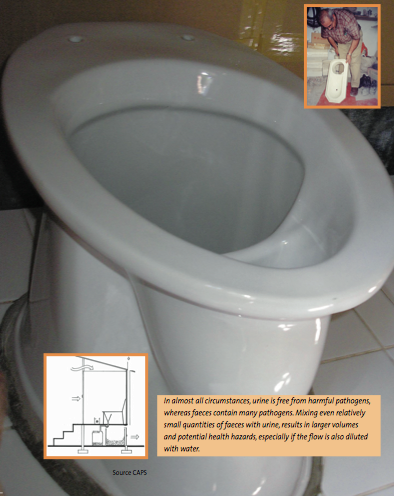Dry urine diversion toilet
We have realised that the old latrine smells and has lots of flies, but the urine diversion system does not have these problems. Thomas, son of a chief in the Chihota district in Zimbabwe. The toilet has two compartments, keeping urine and faeces separate. Urine leaves the toilet through a pipe / tube. Faeces are stored directly beneath the toilet. After defecation, dry soil, ash or sawdust is spread over the faeces, controlling odour and absorbing moisture. Men, as well as women, need to sit while urinating to ensure that the urine is child carrier diverted into the correct channel. Water used for anal cleaning must be kept separate in order not to dilute faeces or pollute urine with pathogens. This requires a separate facility for anal cleaning. Small amounts of anal cleaning water can be infiltrated. Larger volumes need to be treated (together with grey water) to prevent ground water pollution. Dry urine diversion toilets can be made out of ceramic, ferro-cement, fibre-enforced materials, or strong, durable, plastic and painted wood. It is important that the surface is smooth and hardened.
| Advantages | Disadvantages |
|---|---|
| The public health risks are mainly limited to proper handling of faeces. Large scale nutrient recovery is a realistic possibility. |
Special child seats have to be provided to keep their urine and faeces separate. The toilet's operation requires clear instructions and close attention. |
Costs
- Fibre glass pedestal (based on 20 units), US$ 40 (Philippines).
- Ceramic pedestal (based on 400 units) US$ 14 (Philippines).
Applying conditions
- Dry urine diversion toilets are used in regions that are water scarce, flood prone, or that have an impermeable and a high ground water table.
- They are suitable in rural and suburban areas, where urine and faeces can be used in agriculture.
- There needs to be sufficient public awareness about the risks of handling urine and faeces.
Manual
For more information on Dry Urine Diversion Toilets read this document
Animation
External links
- General information www.gtz.de/ecosan
- General information www.ecosanres.org
- General information www.ecosan.nl
- South Africa www.csir.co.za
- Scope, India Dry Urine Diversion toilet in schools

